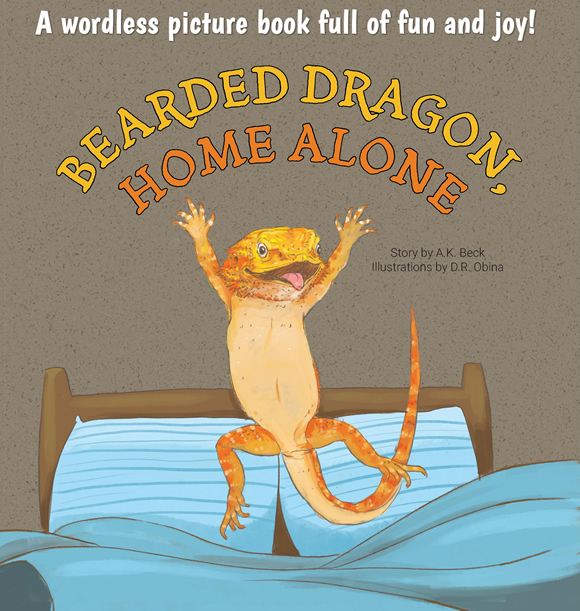Bearded dragon is a quiet, mild-mannered little lizard when others are around. But when this spunky reptile is home alone, it’s a very different story! Let the mischief-making begin in this joyful wordless picture book, a fun-filled romp for kids and grown-ups alike!
Many years ago, when I first started teaching bilingual and multilingual kids at Hiroshima International School, I was filling up my classroom with books…when I came across a picture book that had no text at all. It was a story told only in pictures.
“That’s odd,” I thought. “What’s the value of a children’s book like this? It doesn’t even have any words.”
That was my first impression of a special type of children’s book known as a “wordless picture book.” And I’m aware that this is often the first impression of other teachers and parents, too.
Eventually, though, I came to realize the tremendous value of such books for promoting language development in kids. Moreover, for bilingual and multilingual families, wordless picture books can be used in any language!

Extremely flexible resources
What I’ve found is that wordless picture books are not only a whole genre of beautiful stories told through images (there are so many lovely wordless picture books out there!), they’re extremely flexible resources that can nurture a range of language skills in children of all ages.
*When “reading aloud,” you can tell the story in any language you like. And not only that, you can control the language you’re using to tell the story at the language level of the child. With a regular picture book, the level of the text in the book may or may not effectively match the child’s current level. A wordless picture book enables you to create a perfect match, every time!
*When you don’t feel tied to the text, as with a regular picture book, you gain more freedom to linger over the pages and engage with the illustrations. In my experience, a wordless picture book can actually promote more language use, more input, than regular picture books.
*A wordless picture book also enables the child to more easily “read” the book with, or to, the parent. Again, because there’s no set text that’s pitched at a certain level, the child can “read” the book—tell the story—at whatever level of language ability they’ve already gained.
*Wordless picture books are ideal for creating your own audio books with a device like the Chameleon Reader. With this type of electronic pen, you can embed your voice, telling the story, in special stickers that you affix to the pages of the book. Using the same electronic pen, the child can then listen to these stories, in your target language or languages (multiple languages are possible for each book), whenever they like! It’s a wonderful way to enrich your home in the minority language!
*As children grow older, wordless picture books are also very productive resources for writing practice. Even with my own kids, who are now 17 and 14, I still use wordless picture books by having them write out the story in their own words.

My own wordless picture book
As a teacher, I grew to love using wordless picture books with my students and I built up a nice library of these books over the years. Then, as a parent, I ordered many of the same books (and many more!) for my own kids. As I regularly mention to other parents, wordless picture books have been one of my very favorite resources in my efforts to promote language development in children.
In fact, because these books have long been such a personal favorite of mine, as a writer, I always wanted to create one of my own! But, of course, since a book like this has no words, and I’m not an illustrator, what I would need to do is invent the story then have an illustrator bring this story to life.
And that’s what I did! Like the three coloring books I produced last year (which might also be of interest to you and your kids: Bearded Dragon Daydreams, Bearded Dragon Fairy Tales, and Cat Dreams), I teamed up with my 14-year-old son and the same talented illustrator. And the result of our efforts has just been released!

Bearded Dragon, Home Alone was actually a labor of love in more than one way. Not only do I have a passion for wordless picture books, but the real-life bearded dragon that inspired this book—the sweet little star of our family named Fifa—died quite unexpectedly during the process of making it. This was a heartbreaking loss for us, but we eventually resumed our work and the book became a tribute to her.
As I explain in the back of the book…
Finishing this book after Fifa died was difficult. But it was also the best way to honor the joy she gave to us while she was alive. Because that’s exactly what this book is about: the experience of joy.
And, ultimately, isn’t that what life is about? In spite of the sadness, which can’t be avoided, isn’t it about the simple reaching for joy each day? Isn’t it about seeking to experience as much joy as our brief lives can hold?

Share the book in your language
I’m honestly thrilled with how the book turned out—it looks beautiful—and I’d love for you to share it with your children in your language. It’s now available worldwide, in paperback, at Amazon, the global Amazon sites, and other booksellers. It could make a lovely gift for Christmas.
Get a copy of Bearded Dragon, Home Alone at Amazon.



Thank you for your interest and your support! Please tell me about your experience of the book with your kids! 





